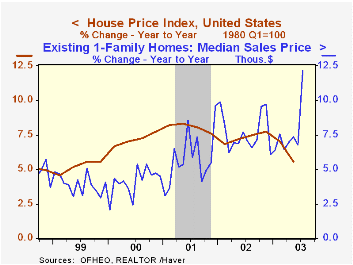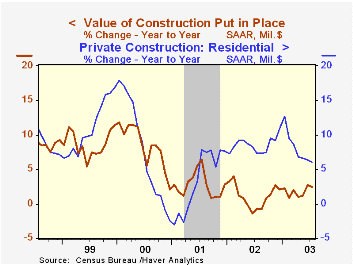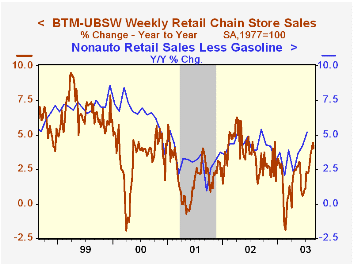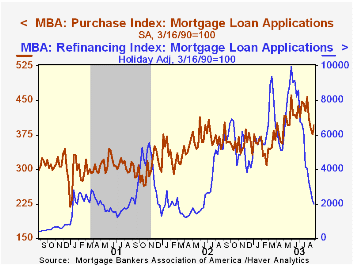 Global| Sep 03 2003
Global| Sep 03 2003Home Price Inflation Slowed
by:Tom Moeller
|in:Economy in Brief
Summary
Prices for existing homes rose last quarter by the smallest degree since 1998 according to the government's Office of Federal Housing Enterprise Oversight. Prices rose 0.8% q/q and 5.6% y/y. Reports for recent quarters of that [...]

Prices for existing homes rose last quarter by the smallest degree since 1998 according to the government's Office of Federal Housing Enterprise Oversight. Prices rose 0.8% q/q and 5.6% y/y.
Reports for recent quarters of that dramatic a slowdown subsequently have been revised to show less deceleration.
The data cover only home mortgages repurchased by Fannie Mae and Freddie Mac and therefore do not cover high priced homes with mortgages over roughly $300,000 (roughly 25% of the market).
The data correct for "mix shifts", i.e., changes in home quality, size and location.
The full press release from the Office of Federal Housing Enterprise Oversight can be viewed here.
| House Price Index | 2Q 03 | 1Q 03 | Y/Y | 2002 | 2001 | 2000 |
|---|---|---|---|---|---|---|
| US Total, Q/Q % | 0.8% | 1.2% | 5.6% | 7.3% | 8.0% | 7.2% |
by Tom Moeller September 3, 2003

The value of total construction put in place rose just 0.2% in July following a 0.7% June gain, revised up from the initial report of no change. A 0.5% July gain had been expected by the Consensus.
Private residential building activity picked up in the last three months following three months of decline. These were accompanied by lower levels of office building, down 3.7% last month and down 18.3% y/y. Manufacturing building also fell 4.9% (-20.5% y/y) in July following a like decline in June.
Public sector building fell last month following three months of strong gain.
These more detailed categories represent the Census Bureau’s reclassification of construction activity into end-use groups. Finer detail is available for many of the categories; for instance, commercial construction is shown for Automotive sales and parking facilities, drugstores, building supply stores, and both commercial warehouses and mini-storage facilities. Note that start dates vary for some seasonally adjusted line items in 2000 and 2002 and that constant-dollar data are no longer computed.
| Construction Put-in-place | July | June | Y/Y | 2002 | 2001 | 2000 |
|---|---|---|---|---|---|---|
| Total | 0.2% | 0.7% | 2.5% | 1.1% | 2.7% | 8.3% |
| Private | 0.5% | 0.0% | 2.5% | -0.2% | 1.4% | 8.0% |
| Residential | 0.6% | 0.4% | 6.1% | 8.6% | 3.3% | 7.4% |
| Public | -0.4% | 2.7% | 2.5% | 5.3% | 7.4% | 9.5% |
by Tom Moeller September 3, 2003

Chain store sales rose 0.1% last week according to the BTM-UBSW survey following a 0.2% gain the week earlier.
The level of sales in August rose 0.9% from the July average. July sales rose 1.4% from June.
During the last five years there has been a 62% correlation between the year-to-year percent change in chain store sales and the change in nonauto retail sales less gasoline.
The BTM-UBSW retail chain-store sales index is constructed from the sales results reported by seven retailers: Dayton Hudson, Federated, Kmart, May, J.C. Penney, Sears and Wal-Mart.
| BTM-UBSW (SA, 1977=100) | 8/30/03 | 8/23/03 | Y/Y | 2002 | 2001 | 2000 |
|---|---|---|---|---|---|---|
| Total Weekly Retail Chain Store Sales | 427.3 | 426.9 | 4.0% | 3.6% | 2.1% | 3.4% |
by Tom Moeller September 3, 2003

The index of mortgage applications compiled by the Mortgage Bankers Association fell last week as applications to refinance plummeted further. Total applications fell 1.6% last week and are down by two-thirds from the weekly peak in late May.
Applications to refinance fell 8.6% w/w. For the month of August refis were about half the level of the month prior and were down 80% from the weekly peak in late May.
Purchase applications have been relatively firm, rising 5.5% last week. For August purchase applications fell 6.3% from the July average which was the peak.
During the last ten years there has been a 55% correlation between the y/y change in purchase applications and the change in new plus existing home sales.
Interest rates on a conventional 30-Year mortgage again were steady last week with the effective rate at 6.50%, about where it has been for three weeks. That was versus a low for 30-Year financing of 5.31% in the second week of June. The effective rate on a 15-year mortgage was 5.89%.
The Mortgage Bankers Association surveys between 20 to 35 of the top lenders in the U.S. housing industry to derive its refinance, purchase and market indexes. The weekly survey accounts for more than 40% of all applications processed each week by mortgage lenders.
Visit the Mortgage Bankers Association site at www.mbaa.org.
| MBA Mortgage Applications (3/16/90=100) | 8/29/03 | 8/22/03 | 2002 | 2001 | 2000 |
|---|---|---|---|---|---|
| Total Market Index | 628.7 | 638.6 | 799.7 | 625.6 | 322.7 |
| Purchase | 396.1 | 375.5 | 354.7 | 304.9 | 302.7 |
| Refinancing | 1,981.5 | 2,169.0 | 3,388.0 | 2,491.0 | 438.8 |
Tom Moeller
AuthorMore in Author Profile »Prior to joining Haver Analytics in 2000, Mr. Moeller worked as the Economist at Chancellor Capital Management from 1985 to 1999. There, he developed comprehensive economic forecasts and interpreted economic data for equity and fixed income portfolio managers. Also at Chancellor, Mr. Moeller worked as an equity analyst and was responsible for researching and rating companies in the economically sensitive automobile and housing industries for investment in Chancellor’s equity portfolio. Prior to joining Chancellor, Mr. Moeller was an Economist at Citibank from 1979 to 1984. He also analyzed pricing behavior in the metals industry for the Council on Wage and Price Stability in Washington, D.C. In 1999, Mr. Moeller received the award for most accurate forecast from the Forecasters' Club of New York. From 1990 to 1992 he was President of the New York Association for Business Economists. Mr. Moeller earned an M.B.A. in Finance from Fordham University, where he graduated in 1987. He holds a Bachelor of Arts in Economics from George Washington University.






